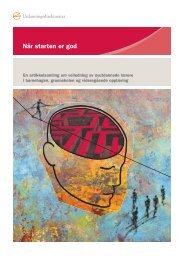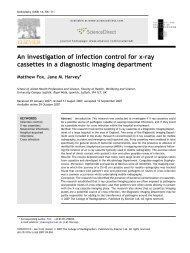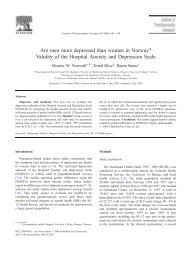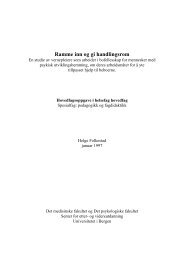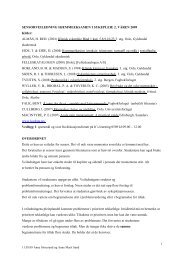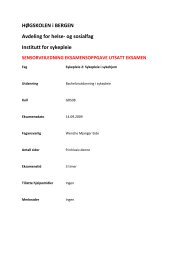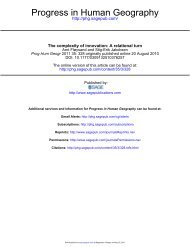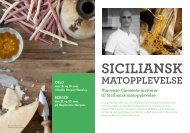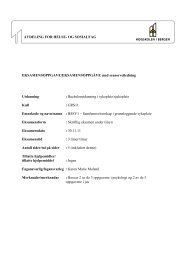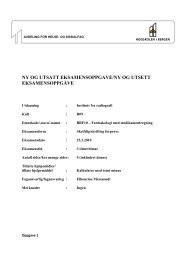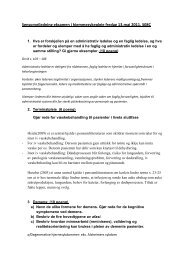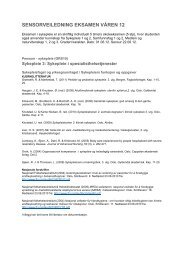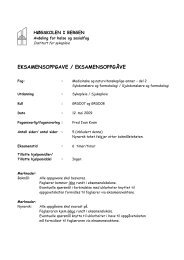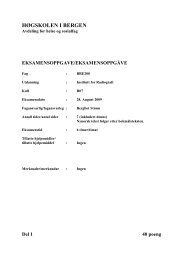Program og oversikt over posterpresentasjoner - Høgskolen i Bergen
Program og oversikt over posterpresentasjoner - Høgskolen i Bergen
Program og oversikt over posterpresentasjoner - Høgskolen i Bergen
Create successful ePaper yourself
Turn your PDF publications into a flip-book with our unique Google optimized e-Paper software.
Results: 38 (0.6%) men and 106 (1.4%) women had O-RCSS, whereas 88 (1.5%) men and 192 (2.5%)<br />
women had CSS. The prevalences of asthma and hay fever were significantly higher in individuals<br />
with O-RCSS compared to those with CSS. L<strong>og</strong>istic regression analyses adjusting for possible<br />
confounders showed increased odds of asthma and hay fever in those with O-RCSS. There were no<br />
differences between the two groups in psychiatric symptoms.<br />
In conclusion, asthma and hay fever are exclusive for those with O-RCSS, whereas psychiatric<br />
symptoms are not.<br />
Kristoffersen M1, Leirdal S2, and Iversen VV1<br />
1 Department of Sport and Physical Education, <strong>Bergen</strong> University College, <strong>Bergen</strong>; Norway, 2Department for Human<br />
movement Science, Norwegian University of Science and Technol<strong>og</strong>y, Trondheim, Norway<br />
Effects of low cadence interval training in cycling (Poster)<br />
Introduction: Low cadence interval training (40-60 RPM at 72-82 %HRmax) is a common training<br />
method for cyclists. The effect of low cadence training on endurance-performance, and muscle<br />
strength is to our knowledge, not investigated. The aim of the present study was to investigate the<br />
effects of low cadence training in highly trained veteran cyclists on 30 min cycling performance,<br />
lactate threshold, VO2max and muscle strength.<br />
Methods: Twenty four highly trained male cyclists age 47.1 ± 5.9 years with a VO2max 59.1 ± 4.03<br />
ml∙kg-1∙min-1 volunteered in the present study. A pre-to post-test experimental design was applied,<br />
with a twelve week training intervention. The subjects were randomised into two groups, one low<br />
cadence training group (Lctg) and one control training group (Ctg). For the Lctg group, low cadence<br />
training was performed as 5 intervals of 6 minutes work periods at 40 RPM and between 72-82<br />
%HRmax, which was performed twice a week in addition to their usual training pr<strong>og</strong>ramme. The Ctg<br />
group performed their usual training pr<strong>og</strong>ramme and in addition an equal amount of extra training<br />
(at freely chosen cadence) per week as the Lctg with a heart rate of 72-82 % of HRmax. At pre and<br />
post-tests; VO2max, lactate threshold, 30 minutes time-trial test and maximal leg strength, was<br />
tested. Tests were performed on a Velotron bike (Dynafit Pro, Racermate USA). Heart rate was<br />
measured using a Polar RS 800 CX, (Kempele, Finland). Oxygen consumption was measured using a<br />
Jaeger Oxycon Pro in mixing chamber mode (Jaeger, Germany). Lactate was measured using a<br />
Lactate Scout (Biosen, Germany) device.<br />
Results: There were no significant improvements in maximal leg strength. The Ctg had a significantly<br />
improvement in VO2max, lactate threshold work rate and VO2. The 30 minutes maximal cycling test<br />
revealed that the Ctg increased the average performance significantly from 278 W to 295 W and the<br />
VO2 utilisation during this test from 52.8 to 54.7 ml∙kg-1∙min-1. Thus, the Lctg group showed no<br />
effect of the training period on any parameter.<br />
Discussion: The present study demonstrates that 12 weeks of low cadence cycling seems to have no<br />
effect on 30 min maximal cycling, VO2max, lactate threshold or muscle strength. In fact, an equal<br />
amount x intensity (training load) of endurance training at freely chosen cadence seems to have<br />
more beneficial effects on VO2max, lactate threshold parameters and a 30 min time-trial<br />
24



